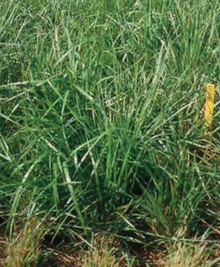Quick facts
-
Endophyte-infected tall fescue causes reproductive issues in horses.
-
Don’t plant endophyte-infected tall fescue in horse pastures or hayfields.
-
Remove pregnant mares from endophyte-infected fescue 45 days before foaling.
-
Horses can safely eat endophyte-free tall fescue.
Identifying
You can’t discern endophyte-infected tall fescue from endophyte-free tall fescue with the naked eye. Tall fescue is a perennial bunchgrass. It’s leaves are dark green, shiny and plentiful. The underside of the leaves are smooth, while the tops are rough from ribbed veins. Horses can safely eat endophyte-free tall fescue.
Tall fescue is moderately tolerant of continuous grazing and has excellent fall productivity. Tall fescue can have marginal winter hardiness and lower palatability.
Where is it found?
Tall fescue commonly grows throughout the United States and Minnesota. You can find it in pastures and hay fields. It also grows on poorly-drained soils.
Toxicity
Endophyte is an organism that lives within a plant. It grows together with tall fescue and has a positive influence on fescue growth including defending the plant from pests. You can’t see the endophyte with the naked eye.
Endophyte induces toxicity in horses. Fescue infected with the endophyte Neotyphodium coenophialum produces chemicals toxic to horses. Infected pasture and hay is toxic for horses to eat. The toxic chemicals in the stems and leaf sheaths tend to peak in late June and decline as the seeds develop.
The toxic chemical content may be higher after nitrogen fertilization and lower during heavy grazing.
-
Reproductive loss
-
Reduced conception rates
-
Prolonged gestation
-
Weak foals
-
Stillbirths
-
Abortions
-
Thickened placentas
-
Lack of milk production
The best approach is to avoid endophyte-infected pasture or feed endophyte-free hay. Remove pregnant mares from endophyte-infected fescue 45 days before foaling.
The best control is to not plant endophyte-infected tall fescue. Most fescue in Minnesota is endophyte-free, but always check the labels of pasture mix containing tall fescue (and other fescues). Endophyte-free fescues are commercially available.
Removing endophyte-infected tall fescue will likely require a major pasture or hayfield renovation. There are no herbicides available to selectively remove endophyte-infected tall fescue from grass pastures or hay fields while keeping beneficial grass species. There are herbicides available to remove all grass species from alfalfa or clover pastures or hay fields.
Reviewed in 2021



